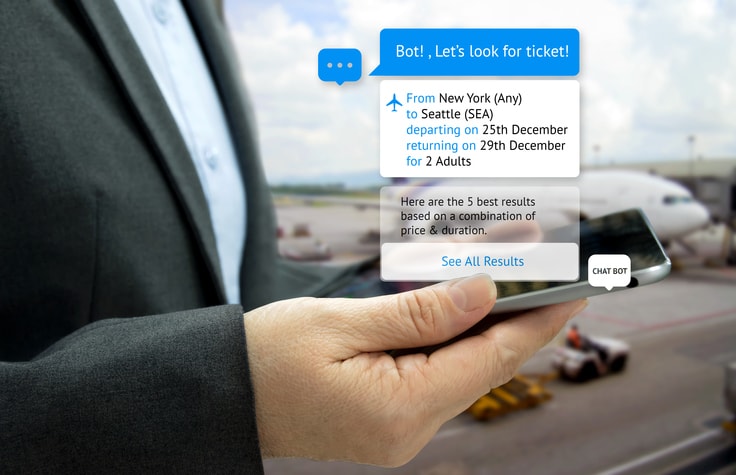If you’ve shopped online recently for a product or service, chances are you’ve encountered a chatbot or two, popping up in the corner of a website to ask if you need help. Perhaps you’ve even engaged with a chatbot, whether you knew it or not, when using a messaging app or chatting with customer service on a website.
Even if you’re not fond of them, chatbots are now part of the online business landscape, and the technology is improving by the minute. What may have seemed like an annoyance in the past is now a tool you can, and should, consider for your business. Don’t think of it as a pop-up your customers will immediately close upon hitting your site—but instead as yet another way to communicate with your customers.
“When integrating machine learning and AI into business, the bot is not just a part of this process and service, but the bot becomes a separate platform for attracting customers, a separate marketing channel, a traffic channel, and sales channel,” says Marina Shumaleva, cofounder and CTO of the travel tech start-up CruiseBe, Inc.
When you think about it that way, chatbots don’t seem like such a nuisance, do they? If you’re thinking of adding a chatbot to your site, follow these seven tips for implementing chatbots in your small business.
Clarify Business Objectives
You don’t want to implement a chatbot on your website or mobile app just because it’s a shiny new toy—you should have a good reason. Ahead of applying chatbots, clarify your business objectives to see how chatbots can help your business succeed. Here are some examples of business goals that chatbots can help you achieve:
- Reducing operating costs by making customer service more efficient
- Creating a new direct sales channel by interacting with customers on your site
- Improving user experience by walking customers through sign-up and purchase processes
Once you’ve defined a business objective, you can begin crafting the appropriate chatbot.
Define Client Needs
Think about your customer, their specific needs, and how they like to interact. Business-to-business (B2B) clients will want something different than business-to-consumer (B2C) customers and vice versa.
Are your clients likely to interact with your chatbot for informational purposes? Will they need help with sign-in or purchase processes? Will they come prepared with questions, or will your chatbot need to prompt them? Whether you’re targeting B2B or B2C customers, make sure your chatbot has smooth chatbot-to-human (C2H) interactions.
Understand the Technical Needs
Like any other major website upgrade, when you add a chatbot you may also need to upgrade your small-business internet service, purchase more server space, or do some additional work to the back end of your site. For example if your chatbot will guide users through numerous point of sale transactions, experts recommend a minimum of 75 Mbps for your internet speed.
To make sure all the technical demands are met, test in-house before releasing the chatbot to the public—you don’t want it to freeze customer browsers or even crash your own site.
Improve Customer Experience with NLP
The most basic chatbots have scripts with built-in “if-then” scenarios to provide answers to frequently asked questions. These can frustrate your customers if they ask questions different from the norm, and thus don’t prompt the correct response from the bot.
Building or implementing a chatbot with Natural Language Processing (NLP) eliminates that issue—NLP bots recognize context and can answer questions based on the intent of words, rather than just following a script. NLP bots are also recommended if your customers often have multiple interactions with your bots, as the bots can make educated guesses based on chat history.
Test Your Bot
“Break your bot, over and over again,” says Curtis Boyd, founder and CEO of Future Solutions Media, an online reputation management firm that uses a chatbot to drive leads for the business. “Try to confuse it. Make sure you have tons of user testing to fix all the bugs, glitches, and prompting cues. Most people who use chatbots will require lots of prompting.”
Depending on your situation it might make sense to outsource some of the development and testing of your chatbot.
Track Your Success and Failure
You probably already have Google Analytics or some other sort of tracking on your website so you can keep an eye on how different pages are performing in terms of time on page, bounce rates, and more.
There are many ways you can use Google Analytics and other tools to gauge how your customers engage with your content and what causes them to convert. Use those tools to see if customers are using your chatbot and if it’s leading to conversions or not.
Remember that Chatbots Don’t Replace Human Beings
No matter how smart AI gets, it still doesn’t replace human interaction. “The most important thing a business owner who is thinking about using chatbots should know is that chatbots are not meant to replace human beings,” says marketing consultant Tabitha Jean Naylor. “Chatbots can provide suggestions and tips, and they can deepen your customer’s experience, but they are not intended to replace your customer service.”
As long as you keep that in mind, chatbots can be a great addition to your small business’s set of tools.
Once you decide whether to add a chatbot on your site, follow these seven steps. By approaching each action carefully, your chatbot can become a helpful addition for driving success.
Alec Sears graduated from Brigham Young University in public relations and business management. He is a digital marketing expert who has written for publications such as Venture Beat, KSL Tech, Lucidpress, and Business.org, among others. He currently lives in the Silicon Slopes of Utah with his wife.







